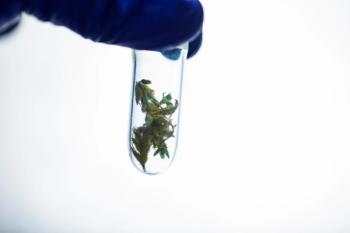
Cannabis Science and Technology
- June/July 2018
- Volume 1
- Issue 2
Cannabis Quality Control Testing Using Gas Chromatography
The cannabis industry has been struggling to keep pace with the changing attitudes toward the drug. With no standardized regulations for quality control between states or countries, there is a huge gap to fill in terms of rigorous testing. The industry is considerably different than the pharmaceutical industry, where drugs pass through extensive quality control to meet stringent safety standards. The challenge for global cannabis producers and processors is how to combat the lack of rigorous testing and oversee quality control to ensure reliable, safe, and consistent products. Gas chromatography (GC) is a successful analytical technique for cannabis testing that provides opportunities to advance the cannabis industry.
The lack of standardized regulations means that producers of cannabis and cannabis-derived products can supply goods unhindered, potentially carrying unsafe levels of pesticides, mold, fungi, and bacteria that can be hazardous to human health. But the cannabis industry is constrained by a legal framework that makes it very difficult to find cannabis with tested cannabinoid content.
This article highlights the work that is being done by Shamanics, a cannabis oil extraction company based in Amsterdam (1). The company works with cannabis, in particular the cannabinoid cannabidiol (CBD), to produce high quality CBD oil. Unlike many of its competitors in the Netherlands, Shamanics conducts key analyses on products before they’re taken to market to provide tested, quality products to meet consumer demand.
Effects of Cannabis
Cannabis consists of the dried flowers of the female Cannabis sativa L. plant, also known as hemp or marijuana, and contains a number of active substances including Δ9-tetrahydrocannabinol (THC) and CBD (2). Through selective breeding, growers have developed strains with different sensory, psychoactive, and medicinal properties.
During the past decade, evidence has been presented that cannabis could have therapeutic effects in a number of major diseases such as epilepsy, cancer, and Gilles de la Tourette syndrome (3). However, as a result of the restrictions imposed on cannabis research, it is thought that many studies were carried out without adequate control trials or sample sizes. For patients who rely on cannabis for medicinal use to ease their symptoms, safety and consistency are difficult to guarantee. To be considered as a drug for medicinal use, cannabis shouldn’t be different from any other pharmaceutical. In the pharmaceutical industry, consumers trust that prescribed medication has been tested to contain no harmful contaminants and a precise dose of an active pharmaceutical ingredient. As the cannabis industry becomes increasingly transparent, there is scope for the increased testing and research that consumers demand.
The Growing Legal Market
Traditionally, there have been blurred lines between countries and states on their rules and regulations around cannabis, for both medicinal and recreational use. In the United Kingdom, the possession and supply of cannabis is illegal but there have been a number of cases where cannabis has been prescribed for medicinal use. One example of cannabis prepared for medicinal use is the drug Sativex, which has THC as an active compound. It is also possible to buy CBD oils from high street stores in the UK, but those products have usually been extracted from hemp rather than cannabis (4).
In contrast, 30 states in the U.S. have legalized cannabis for medicinal use (5). California’s legalization of recreational cannabis in January 2018 was a huge milestone in the industry. And with legalization comes regulation; the state has imposed stringent rules around standardized quality testing of cannabis products including pesticide testing. All legal cannabis must be tested for residues of 66 pesticides listed by the Bureau of Cannabis Control.
Despite this movement, cannabis isn’t classified as a medicine because it remains illegal under federal law, set at the U.S. government level. Subsequently, the U.S. Food and Drug Administration (FDA) has not approved the plant or plant extracts as a medicine. However, Δ9-THC, the main psychoactive ingredient in the Cannabis sativa L. plant, has been an FDA-approved drug for more than 25 years.
Navigating the landscape of cannabis testing in comparison to the imposed regulations is complex. For example, Massachusetts legalized cannabis for medicinal use but required safety and potency testing by a third-party for all products despite it being illegal to operate a cannabis testing laboratory in the state.
Despite this backdrop, the cannabis market is forecasted to continue to grow. A recent report suggested that medical marijuana sales will grow to $13.3 billion in 2020 and adult recreational sales are estimated to reach $11.2 billion by 2020 (6).
The Need for Testing
It’s important that imposed regulations aren’t time-consuming and expensive to implement, or there is a risk of people turning to the black market to get around them, offsetting the initial aim of the regulations in keeping the public safe. New testing laws increase costs for manufacturers on top of the license and permit fees they are required to pay. Push back from producers is imminent with the implementation of new regulations, but this interaction is necessary to upgrade the cannabis industry and ensure that high-quality products are being made.
In the past, testing wasn’t typically carried out in-house because of the perception that analytical instrumentation is too expensive and complex, requiring a deep understanding of analytical chemistry. However there are technologies and instrumentation available that are easy to use, cost-effective, and adapted for users with minimal experience. Gas chromatography (GC) is a widely used analytical tool for cannabis testing that enables potency testing, terpenes profiling, pesticide screening, and residual solvents analysis—knowledge that can significantly benefit the cannabis industry. With access to these robust testing techniques, companies can accurately determine the active cannabis ingredients, providing vital information in a competitive marketplace. This, in turn, builds consumer confidence and aids market growth.
Typically, the primary cannabinoids of interest for potency testing are THC, CBD, and cannabinol (CBN). A key goal in cannabis analysis is positive identification and quantification of the THC:CBD ratio. For medicinal cannabis, CBD is the primary component of interest because it is often characterized by high levels of CBD and low levels of THC. In contrast, recreational cannabis typically has high levels of THC—the main psychoactive ingredient—and low levels of CBD.
Cannabis Testing in the Home of the Coffee Shop
Despite the perceived relaxed laws around cannabis consumption in the Netherlands, where tourists can legally consume cannabis in coffee shops, restrictions remain on growing and purchasing the drug (7). As a result, many consumers, including coffee shops, have to turn to the black market to acquire the product, where testing remains very rare.
Shamanics’s goal is to upgrade the cannabis scene in the Netherlands using GC to protect and grow the market. The company uses GC for quality assurance of its products and offers a testing service for coffee shops in Amsterdam to test the quality of their cannabis. The company conducts terpene analysis and potency testing. When testing for potency, they analyze total THC and CBD. When testing by GC, the acidified versions of the cannabinoids are converted to the neutral forms in heat of the GC injector (Figure 1), so the results of the neutral THC and CBD peaks will represent the total values. (See upper right for Figure 1, click to enlarge; Figure 1: Decarboxylation of THCA in the GC injector.) If the levels of the acidic and neutral cannabinoids are required separately, they can be tested with GC by derivatizing the sample before analysis (Figure 2). (See upper right for Figure 2, click to enlarge; Figure 2: Derivatization of THCA.) This process protects the acidic cannabinoids from converting to their neutral forms in the GC injector. The total cannabinoid value is then calculated by adding the amount of neutral version present together with the amount of neutral version that could be created by the decarboxylation of the acidic version of the cannabinoid present.
Experimental
A typical analysis completed at Shamanics’s laboratory in Amsterdam is shown in Figure 3. (See upper right for Figure 3, click to enlarge; Figure 3: Chromatogram showing the terpenes and cannabinoids separated in a single run.) The chromatogram shows the concentration and profile of the terpenes and cannabinoids in a cannabis sample to establish the potency, the flavor profile, strength, and therefore, quality.
Materials
First, 0.1 g of cannabis was added to 30 mL of methanol at ambient, shaken for 30 s and left to extract for 30 min. An aliquot of the extractant liquid was then collected through a syringe filter and placed in a sample vial ready for analysis. The analysis was performed using a 200 Series GC system with flame ionization detection (FID) (Ellutia) and a 30 m x 0.25 mm, 0.25-µm film thickness EL-5 column (Ellutia). The standards used for the calibration were a standard three-component cannabinoid mix (Restek Cat.# 34014: Cannabinoids Standard) and a 19-component terpene mix (Restek Cat.# 34095: Medical Cannabis Terpenes Standard #1).
GC Conditions
The GC conditions are listed in Table I. (See upper right for Table I, click to enlarge; Table I: GC conditions.)
Results and Discussion
The results show that this sample has 601.226 µg/mL of THC. This results in the sample having a total THC content of 18%.
Figure 4 shows a high level of THC and suggests that if consumed it would have more of the psychoactive effects. (See upper right for Figure 4, click to enlarge; Figure 4: Cannabinoid detail from chromatogram.) The results include the ratio of THC and CBD, providing information about the potency of the product. Figure 5 shows the concentration and profile of the terpenes that are present, providing information about the flavor profile that guides users about the sort of flavor characteristics that can be expected from the cannabis when consumed. (See upper right for Figure 5, click to enlarge; Figure 5: Terpene detail from chromatogram.)
The variations in terpenes present and their subsequent levels define how that strain of cannabis will smell and taste. As an example, a strain showing high levels of limonene may have a citrus lemon aroma (limonene is also commonly found in lemons). Similarly, a high level of myrcene will give flavors similar to beer (myrcene is also commonly found in hops). The levels of terpenes can also be used as a guide to understand the quality of the product. For example, low levels could indicate that it has not been dried correctly. This information enables manufacturers to verify the quality of the final product.
Conclusion
It is evident that the cannabis industry still has a distance to go in terms of quality control. With no centralized regulatory body responsible to ensure stringent safety standards, the responsibility lies with the grower, manufacturer, and even the individual consumer.
Access to affordable, robust analytical techniques, such as GC, enables products to be tested to measure the cannabinoid and terpene content and determine its overall quality, providing reassurance to consumers throughout the supply chain. In the case above, GC testing determined the overall THC content to be 18%. This is a high level of THC and can therefore be expected to have psychoactive effects, providing crucial information for commercial purposes. It is critical to comply with fast-changing regulations to provide consistent, tested products in a highly competitive marketplace.
Ultimately, if cannabis wants to be considered a medicine, it needs to be manufactured and tested with the same care that is given to all medicines in the pharmaceutical market.
References:
https://shamanics.nl/ .- C.M. Andre, J.-F. Hausman, and G. Guerriero, Front Plant Sci. 7, 19 (2016).
- “Clinical Studies and Case Reports,”
https://www.cannabis-med.org/studies/study.php (2016). - “Emc, 2018,” Sativex Oromucosal Spray
https://www.medicines.org.uk/emc/product/602/smpc . - “Governing – the states and localities,” State Marijuana Laws in 2018 Map,
http://www.governing.com/gov-data/state-marijuana-laws-map-medical-recreational.html (2018). - New Frontier Data, “The Cannabis Industry 2017 Annual Report,”
https://newfrontierdata.com/annualreport2017/ (2017). - G. Haines, “Everything You Need to Know About Marijuana Smoking in the Netherlands,” The Telegraph,
https://www.telegraph.co.uk/travel/destinations/europe/netherlands/amsterdam/articles/everything-you-need-to-know-about-smoking-marijuana-in-the-netherlands/ .
Andrew James is the marketing director at Ellutia. James has worked at Ellutia for more than 20 years, during that time he has been involved with many aspects of the business from product development to strategic planning. Through this wide range involvement, he has developed an extensive wealth of knowledge and experience in the chromatography industry. James has been in charge of the company’s marketing for the last eight years, working to continually grow both the Ellutia brand and company as a whole. Direct correspondence to:
How to Cite This Article
A. James, Cannabis Science and Technology 1(2), 32-37 (2018).
Articles in this issue
Newsletter
Unlock the latest breakthroughs in cannabis science—subscribe now to get expert insights, research, and industry updates delivered to your inbox.





